My husband worries when I leave for a horse safari in Africa. “You’re like the pickle on top of a hamburger,” he frets, knowing from past excursions that encounters on horseback with lions are not unlikely. Others hold this opinion as well, as evidenced by the reactions of tourists in Range Rovers. Just after seeing two lionesses and a massive black-maned male lion deep in the African bush, they encounter nine riders on horseback. The looks on their faces are clear: they think we’re lunatics.
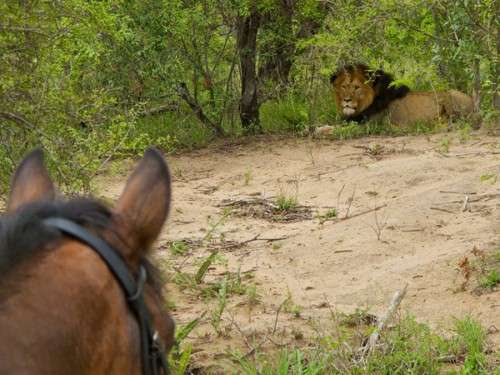
Indeed, I’ve questioned my own sanity at least twice, after galloping into a pride of lions. Well, I exaggerate: on one occasion, our guide spotted the lions just before we reached them, and we pulled the horses up short. But on the other, in South Africa, we rounded a corner and startled four adult lions snoozing under bushes. The lions bolted off in four different directions.
When a horse is confronted by the wall of scent left in the wake of fleeing lions, his fear is palpable. As we stopped to assess the situation, I could feel my horse’s heart pounding under the saddle leather between my legs. The jugular vein at the base of his throat pulsed in the same wild rhythm. At this point, my only goal was to keep him calm. If a horse bolts, the lions (if they’re still around) will almost certainly follow—nothing stimulates their hunting instinct like the sight of fleeing prey. I focused on relaxing the muscles in my seat, offering my horse a reassurance I did not feel. I patted his neck and said, “You’re fine.” In the huddle of horses, I bumped knees with my friend Barney, and she apologized. I told her the bump was welcome—proximity was a comfort.
As we calmed our horses, we riders asked one another, “Where exactly did the lions go?” And we answered, “I don’t know.” We searched the riverbed for golden-brown movement.
True confession: I find these situations thrilling. Not that I seek them out; at least, not exactly. It would be insane to deliberately gallop a horse into a gathering of lions. But if that happens, when out of the blue there are lions where there were none, and it’s not clear what will happen next, the rules are plain: Stand still. Stay calm. Look around. Find the lions.
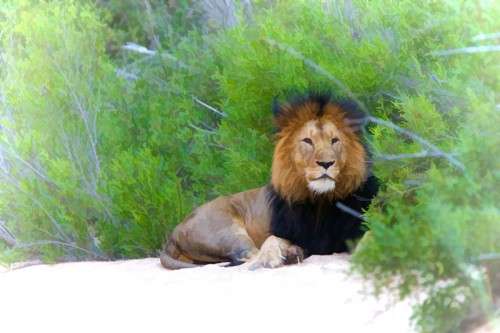
Alas, I lack most of the skills required to find lions, and this bothers me. On my first trip to Africa, nearly 20 years ago, my husband, two friends, our guide Charles, and I spent a morning with a reformed poacher named Daveson, who was employed as a tracker in Zimbabwe’s Matusadona National Park. Early that morning, Daveson spotted black rhino tracks on a dirt road. He said they were fresh, so we alighted from the vehicle and began walking. At the start, my friends and I were abuzz with excitement at the prospect of seeing a rhino. We looked behind every tree and bush, hoping a rhino would appear. Three hours later, we were sweaty, hungry, tired, and disheartened. Every hundred yards or so, Daveson pointed to a scrape in the ground or an overturned leaf and told us an increasingly unbelievable story about a rhino cow and calf walking together, with a bull meandering in their wake. After four hours, Charles pulled Daveson aside and said, “I think we’re on a wild goose chase.” Daveson turned to him and said sternly, “There are no geese here.”
Four and a half hours into the walk, Daveson pointed to a depression in the sand made by a sleeping rhino, creases from her skin visible in the pliant earth. A few minutes later we saw fresh rhino dung, steaming. Ten minutes after that, we spotted three black rhinos: a cow, her month-old calf, and a bull. Just as Daveson predicted.
And as we spotted them, the rhinos scented us. Their reaction was a typical rhino reaction: they charged blindly forward. Fortunately, forward was not in our direction—but the sound of half-ton animals crashing through bushes sent us tourists skittering together into a close clump. Like horses scenting lions, our instincts told us to gather. We bumped elbows in reassuring proximity. Hearts pounding, and we looked to Daveson for direction. He said to stay calm and stand still, and we stood.
During the year after I graduated from college, I worked for Howard Gardner, a cognitive psychologist interested in human intelligence—only he didn’t refer to “intelligence,” since the singular form assumes intelligence is unitary. Instead, he talked about “intelligences” and divided them into categories, each managed by a distinct neural circuit.
The Western world values intelligences like verbal fluency and mathematical reasoning, which enable us to navigate an age of information technology. But these aptitudes aren’t much help when it comes to tracking rhinos or reading the intentions of lions. Gardner identified other intelligences that might, including an interpersonal intelligence through which we identify the feelings and motivations of others (perhaps including animals), and a spatial intelligence that confers a sensitivity to nature and our place in it. Daveson had a genius-level IQ in these domains. Alas, I deliberately use the past tense—Daveson died of AIDS two years after I met him.
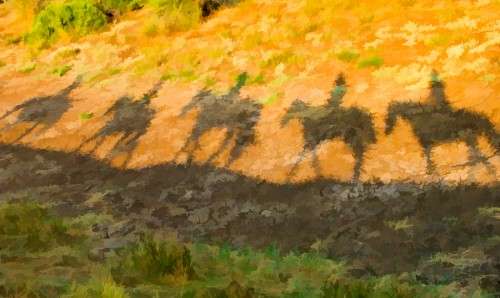
On a horseback safari, the guide makes every effort to spot tracks and direct riders away from danger. But even the most observant guide cannot see lion tracks that are not there, if the lions have arrived from an altogether different direction. That was the situation in South Africa when we cantered along a riverbed and scattered four sleeping lions. It was dusk. We needed to get back to camp before the sun set, but we didn’t know where the lions went. We walked the horses slowly, watching the bushes for movement and staring at the ground for tracks. We monitored our horses’ ears and eyes, because they will detect lions before we do.
As a dressage rider, the hardest thing for me on horseback in Africa is to trust my horse. Dressage is an equestrian sport that’s about absolute control, of horse, body, and mind. It demands perfection at each step, in both horse and rider; it’s like figure skating on horseback. Dressage riders are control freaks—and riding on horseback in Africa is the opposite. Riding in Africa is about mutual trust. It’s about understanding that your horse sees the terrain better than you do, and that his senses are more attuned than yours to predators.
On my first horseback safari, in Botswana, we rode through terrain that I had walked many times before—not the identical ground, but places so similar I sensed the dangers: warthog holes, snakes, burrows, and fallen branches, any of which could trip my horse and hurtle us both earthward. Were it up to me, I would have walked my horse everywhere. But I was on a trip with experienced cross-country riders who not only enjoyed a sporty canter in the bush, but loved a flat-out gallop on an open plain.
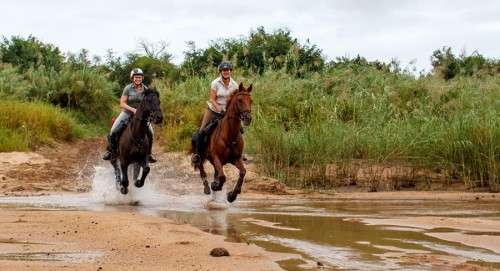
I wish I could say I loved those gallops, but I did not. I was terrified. I’ve never felt so out of control as standing in the stirrups on a horse running in a full-out race with his stablemates. I was white-faced, ashen. I prayed my horse would spot every hole and log, and tried to trust him—and, thankfully, he was trustworthy: he jumped every hole and log with ease.
During that safari, in March 2007, the floods came early to the Okavango Delta. The Delta is a table of land that, thousands of years ago, dropped several dozen feet below its ancient height due to seismic activity. Every year, just to the north in Angola, seasonal rains fill the Okavango River, which courses southward. The river flowed to the ocean in ancient times, but then it lost its way. Now, without a continual downhill trajectory, it wanders aimlessly and forms a vast inland delta that ends in no sea. During summer in Botswana (our winter in the US), the Delta’s plains are open and dry. But as the rains in Angola flood the river and send water southward, Botswana’s seasonal plains fill with water.
That March, the Delta was unusually wet—but the crocodiles from Angola had yet to arrive, so we rode our horses into the floodwaters, which had reached a depth of about a foot and a half. The horses were eager and pawed in excitement. We galloped into the floods, our horses’ hooves sending buckets of water skyward to drench us. We raced blindly across the plain, trusting the ground to be level. Twice, a horse and rider disappeared in front of me, immersed in invisible underwater gullies. But falling into water is painless—after vanishing, horse and rider stood, shook, regrouped, and galloped on. We cantered the horses eight abreast, water splashing wildly, backlit droplets catching the sun. We felt a simple, exuberant, purposeless joy. For the first few days on horseback in Botswana, I felt afraid and out of my element; by the end of the trip, I didn’t want to leave.
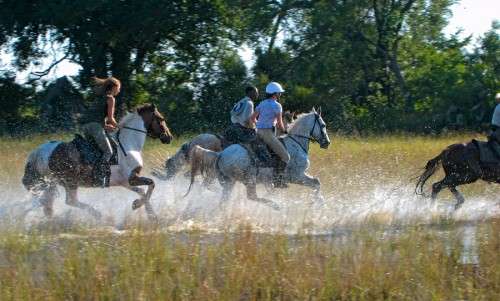
And so I return, again and again, to experience Africa from horseback. As we rode home after scattering the four lions in South Africa, our guide Philip directed his horse up a riverbank to head back toward the lodge. Halfway up the bank, he turned and rode back to the riverbed. We followed, and a few moments later, we spotted all four lions, crouched in a thicket monitoring our progress. Knowing where they were was a relief; we were giddy on the ride back to camp. Later, at the lodge, I caught Philip’s attention. I pointed out that he seemed to have changed his mind, back on the riverbank. He could have taken us straight home. He looked at me and nodded. “I really like lions,” he said, his eyes crinkling ever so slightly.
As you might have surmised, so do I.


Susan McConnell
5 Jul 2014Wondering where to ride in Africa? There are options for riders at all levels, but you should be highly experienced to ride in reserves with dangerous game like lions, elephants, and rhino. My favorite place (having been there at least six times) is Wait A Little in South Africa’s Karongwe Reserve. Philip and Gerti Kusseler run an excellent operation with fit, responsive horses trained in dressage, outstanding guiding, sporty riding, and amazing food. For more information, see their website at http://www.waitalittle.co.za/. Other terrific places to ride with big game include Limpopo Valley Horse Safaris in Botswana’s Tuli Block, and African Horseback Safaris and Okavango Horse Safaris in the Okavango Delta. (I haven’t yet ridden in Kenya or Namibia, but would love to!) Two operations that are appropriate for riders at all levels are Wild Coast Horse Trails in South Africa, and Mozambique Horse Safaris in Vilanculos, Mozambique – both offer rides along gorgeous stretches of coastline.